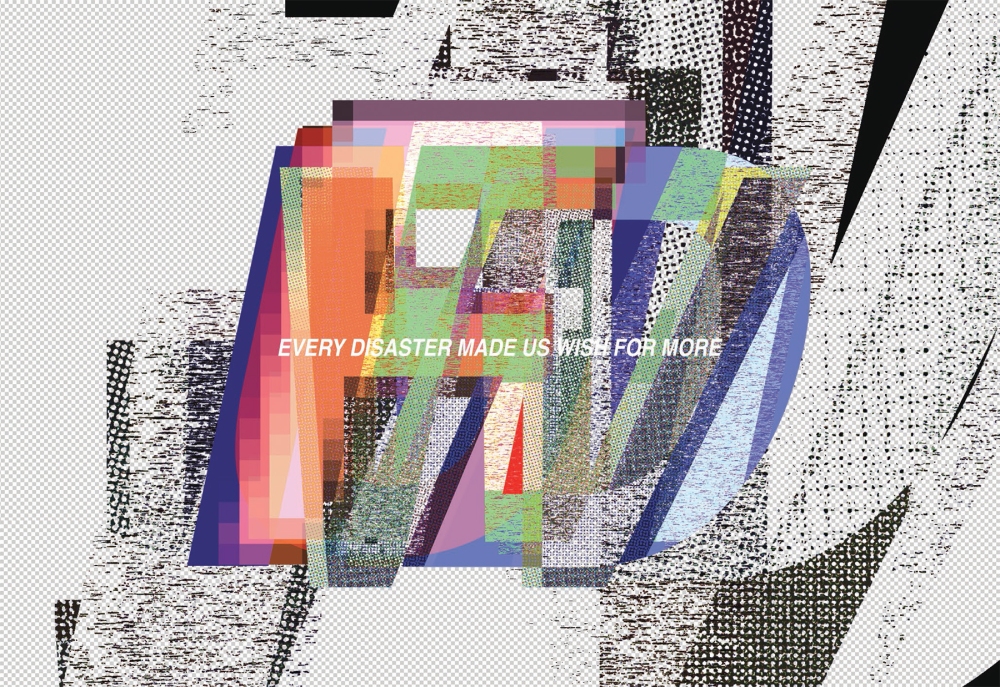To commemorate the 2017 MFA thesis exhibition Every Disaster Made Us Wish For More, the USF graduate artists and art historians collaborated to produce a professional exhibition catalogue. This year marked the third occasion that USF artists and art historians created a catalogue, continuing a tradition that was founded by the exceptional efforts of previous classes. The catalogue features essays written by art historians and dedicated to artists in the exhibition, with both parties working together to celebrate the artwork and writing being produced by the USF arts community. For this catalogue, I was fortunate to be the art historian responsible for coordinating essays, which was a challenging yet immensely rewarding experience.

Original design by Kate Kinder, 2017
One of the first steps in producing the catalogue is pairing up artists and writers. Forgoing the tried-and-true method of drawing names out of a hat, instead we organized a dinner where artists and writers could casually discuss their work before deciding to collaborate. This is a critical point in the process because some people will share common interests and have personalities that are well-suited to each other, and every possible combination would result in an entirely different essay. For instance, I wanted to work with painter Brandon Geurts because I was intrigued by his desire to create an empathetic connection between viewer and figure, and I was also drawn to his striking use of color and the inspiration he found in horror films. However, another writer working with Geurts may have focused more on themes of body horror or gender fluidity or spent additional time situating his artwork in relation to other contemporary painters. To learn more about his work, you can visit his website at: http://www.brandongeurts.com/
 Brandon Geurts, Gumming For A Sound Bite, 2017
Brandon Geurts, Gumming For A Sound Bite, 2017
The studio visit is the next major stage of the writing process. It is up to each pairing to decide how often they meet and if there should be multiple interviews. This was only my second time interviewing an artist in studio, and I still find it a strange experience. You do not really see the artist in-action, but instead you glance over works in progress or witness the messy aftermath of a completed artwork. Unless the artist lets you observe them make work, you are left to mentally puzzle together their process as you interview them. The artist can provide additional clues through suggesting readings, artists to look at for reference, or other materials that might help the writer understand what the artist wants to achieve. In my case, Geurts gave me “homework” in the form of a movie watch list that included David Lynch’s Mulholland Dr. and Eraserhead, David Cronenberg’s Videodrome and The Fly, and more recent movies like It Follows, The Guest, and Under the Skin. Although I did not make it through the entire list, I watched enough to get a sense of the monstrous subjects and body discomfort that connected to the artist’s paintings.

After the first studio visit, writers have to put their newfound knowledge to use and write the essay. The nature of this stage varies between each pairing, as some artists will want to be more involved in the writing to make sure that they are being accurately represented. As writers send drafts to artists, the artists can make suggestions for revision, add additional content, and both parties may decide that a follow-up interview is needed to gain a fuller understanding of the major themes at play. This back-and-forth exchange requires particular sensitivity since it is critical to find the right balance between celebrating the artist’s work, addressing any concerns, and also retaining the writer’s voice.

Brandon Geurts installation at MFA thesis exhibition. Photo by Will Lytch
Each essay also has its own set of challenges. Although every essay is reviewed by multiple editors, this sequence is the most frenetic and intense part of the project. Due to the timing of the exhibition, writers are often discussing works that are in progress and subject to numerous changes. For artists, it can be equally difficult trying to explain their work while they still have a thousand ideas bouncing around in their heads. For me, I felt comfortable discussing the overall direction of the artist’s work, though he did request that I pull back on explaining his painting process. I also had a frustrating time titling the essay, since Geurts is known for great titles and everything I tried felt like a poor imitation of his style. Ultimately, I went to the source and chose the essay’s title from a few of his suggestions and I think we were both happier with the end result.

Overall, organizing the essays for the MFA catalogue was an invaluable experience that taught me how to work with and write about contemporary artists. For writers who focus on contemporary art, this project allows them to gain experience working in a field that they will one day enter as professionals. Although contemporary art is not my specialty, I was able to expand my critical thinking about art to include active exchange with a working artist. I am incredibly proud of the achievements of the artists and writers, and I expect the catalogues to improve each year. Next year’s class has a high standard to live up to, so good luck to them!
You can view a digital version of the catalogue and read the full essays here: http://cam.usf.edu/CAM/exhibitions/2017_3_Every_Disaster/MFA2017-Catalogue-lowres.pdf
James Cartwright
M.A. Candidate
School of Art and Art History
University of South Florida